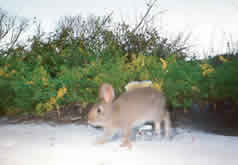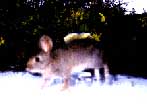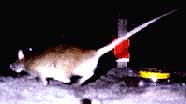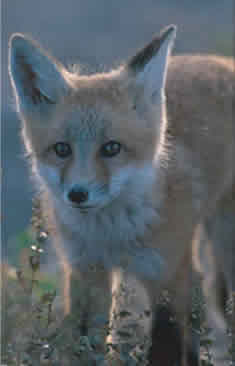|
YLR
Home | Overview
| Animals
| Plants | Research
| Geology
| Peregrine Falcons
| Sounds
of YLR Seasons
| Tours
| Volunteer |
Directions
to YLR | Contact
Us
|
Mammals of Younger Lagoon Reserve |
| Younger
Lagoon is part of the natural range of many mammals, and is connected
by open space to large wild areas of the nearby Santa Cruz Mountains.
So-called introduced exotic species, or non-California
natives, also visit the lagoon. Younger Lagoon Reserve by itself, at a mere 25 acres, is not enough habitat to sustain most of the mammal species that use it. But as part of a series of small to large preserved places it provides valuable habitat to many species that could not survive in the surrounding areas that have been modified by human use. By providing habitat in multiple pieces throughout a larger developed area we can help sustain species that otherwise would not be able to survive in the region (as long as those species can move among those habitat pieces). |
 Brush Rabbit |
|
In 1993 UCSC students Kelly Finn, Shay Hilleary, Chelsea Lopes
and Kerry Stanton set up a photographic feeding station at Younger
Lagoon as part of a Senior Thesis Project
to survey animal traffic in the area. As seen by these "self
portraits," numerous mammals make YLR part of their nocturnal
meanderings. |
|
This
species list is derived from student field studies and from
species expected to occur at YLR, according to the Wildlife
Habitats Relationship database of the California
Department of Fish and Game. We have omitted species that, although
they might possibly occur, are unlikely due to reserve size, isolation
or habitat availability. We have included all the bats and omitted
marine mammals. The list is organized according to taxonomic classification
in the following format:
code: X = CONFIRMED BY SURVEYS BY SIGHTING, TRAPPING, PHOTO STATION, TRACKS OR SIGN X* = SHREW NOT IDENTIFIED TO SPECIES, BATS WERE SIGHTED FLYING, NO POSITIVE IDENTIFICATION E = EXOTIC SPECIES, TO BE KEPT OUT ? = REPORTED CASUAL SIGHTING |
|
Exotic Species
|
 Striped
Skunk The striped skunk, Mephitis mephitis,
is a common visitor to homes and trash cans even in urban Santa
Cruz. We are all familiar with its defense mechanism, especially
those of us with overly curious dogs or open spaces under our houses
where expectant mother skunks find good sheltered places to raise
their babies. This skunk, like the other mammals on this page, is
sniffing a can of tuna fish left between our automatic camera and
an infrared beam that triggers the camera. Skunks will eat just
about anything, garbage, cat and dog food, eggs and baby birds,
insects, etc.
Striped
Skunk The striped skunk, Mephitis mephitis,
is a common visitor to homes and trash cans even in urban Santa
Cruz. We are all familiar with its defense mechanism, especially
those of us with overly curious dogs or open spaces under our houses
where expectant mother skunks find good sheltered places to raise
their babies. This skunk, like the other mammals on this page, is
sniffing a can of tuna fish left between our automatic camera and
an infrared beam that triggers the camera. Skunks will eat just
about anything, garbage, cat and dog food, eggs and baby birds,
insects, etc.  Gray
Fox This gray fox, Urocyon cinereoargenteus,
had its picture snapped several times during our study; it appears
to be very fond of tuna fish. We suspect gray foxes have a den inside
the Younger Lagoon Reserve and have bred there. These gray foxes
are native to the Santa Cruz Mountains and unlike the very unwelcome,
introducted Red Fox, they do not decimate shore breeding bird populations
such as snowy plover. They are also fond of garbage and seem to
do fairly well around the edges of built areas.
Gray
Fox This gray fox, Urocyon cinereoargenteus,
had its picture snapped several times during our study; it appears
to be very fond of tuna fish. We suspect gray foxes have a den inside
the Younger Lagoon Reserve and have bred there. These gray foxes
are native to the Santa Cruz Mountains and unlike the very unwelcome,
introducted Red Fox, they do not decimate shore breeding bird populations
such as snowy plover. They are also fond of garbage and seem to
do fairly well around the edges of built areas.  Brush Rabbit
The brush rabbit, Sylvalagus bachmanii, is
the common brush bunny of the Santa Cruz area. Smaller that the
Audobon's Cottontail it prefers the bush country of our coast ranges.
The brush bunny is an herbivore - it eats mostly tender young shoots
(when it can get them) and it lives on the greens because it carries
bacteria that digest the cellulose in its hind gut. To get the benefits
of the digestion done by the bacteria the bunny eats its own feces
every night, digests the bacteria too, and then absorbs the nutrients
as they pass through the second time, fullly digested.
Brush Rabbit
The brush rabbit, Sylvalagus bachmanii, is
the common brush bunny of the Santa Cruz area. Smaller that the
Audobon's Cottontail it prefers the bush country of our coast ranges.
The brush bunny is an herbivore - it eats mostly tender young shoots
(when it can get them) and it lives on the greens because it carries
bacteria that digest the cellulose in its hind gut. To get the benefits
of the digestion done by the bacteria the bunny eats its own feces
every night, digests the bacteria too, and then absorbs the nutrients
as they pass through the second time, fullly digested.  Our Woodrat,
Neotome fuscipes, has relatives in our desert that we call
packrats. These are rodents but are not closely related to the introduced
black and Norway rats that have caused humans so much trouble over
the centuries. The wood and pack rats build large nests of branches
(including cactus where it is available) that are shared by the
rats, passing through the generations from mother to daughter.
Our Woodrat,
Neotome fuscipes, has relatives in our desert that we call
packrats. These are rodents but are not closely related to the introduced
black and Norway rats that have caused humans so much trouble over
the centuries. The wood and pack rats build large nests of branches
(including cactus where it is available) that are shared by the
rats, passing through the generations from mother to daughter.  The
Red Fox, Vulpes vulpes,
is an exotic, non-native species that has been reported
at Younger Lagoon. It is considered a threat in this area because it
hunts ground nesting birds that have not adapted to live where
there are such predators. The Red Fox is slowly replacing the
native Gray Fox in many areas, due largely to the effects of human
activities.
The
Red Fox, Vulpes vulpes,
is an exotic, non-native species that has been reported
at Younger Lagoon. It is considered a threat in this area because it
hunts ground nesting birds that have not adapted to live where
there are such predators. The Red Fox is slowly replacing the
native Gray Fox in many areas, due largely to the effects of human
activities.